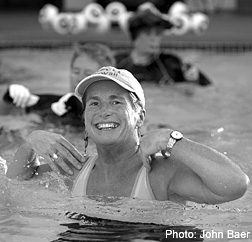 . |
|
 Pauline Ivens, water exercise instructor |
|
|
choice for health and fitness. Water
exercise classes are increasing at a rapid rate across the country,
but it is still surprising how many people are unsure just what it
is. In swimming, the body moves horizontally in
a streamline motion to cut through the water with speed and
efficiency. In water exercise, the body stays vertical,
intentionally engaging as much of the water’s resistance as
possible for the hardest physical workout. It’s a simple equation
– the water pushes back as hard as you push against it – making
water exercise one of the most effective workouts for any age or
fitness level. Water’s resistance provides a tough
workout for athletes who want to increase the volume of their
training without increasing the risk of impact-related injuries.
Water exercise is most popular with baby boomers, who are already
regular exercisers, but need an environment that has less impact
while still providing all the fitness components and benefits. The
surrounding resistance and buoyant support are incredibly valuable
to older adults who can improve their ability to perform daily tasks
without the fear of falling. Some people think water exercise is wimpy,
but that couldn’t be further from the truth. In fact, one of the
best things about water is that you can do cardiovascular training,
strengthening and flexibility all at the same time! The powerful
resistance overload provides for muscular conditioning, plus
cardiovascular training by using vigorous lower body movements like
water running. The level of immersion reduces impact on the joints
without reducing the amount of effort you can put into the workout.
The very popular deep-water classes become totally non-impact. The
water is also very accommodating: it provides variable resistance so
each person can modify the intensity of the workout to their own
fitness level. Is there a down side? You have to get wet!
If you join a group exercise class, you want to get a good
instructor. No one wants to exercise without getting results.
Pauline Ivens, a national water exercise presenter and instructor
trainer who lives on Oahu, says you need to look for classes taught
by certified instructors. Like all branches of the fitness industry,
water exercise also has national standards, and the minimum
expectation is for an instructor to hold a fitness certification. Ivens is currently providing the AEA
(Aquatic Exercise Association) Aquatic Fitness Instructor
Certification for instructors on Oahu, “I have discovered that
many instructors are teaching without this minimum qualification,
and that really risks the safety and effectiveness of the
classes.” Another difficulty is that many pools are
not heated. The national guideline for water exercise classes set by
AEA is 83-86 degrees. This is rarely available in unheated island
pools. The working muscles need to maintain a certain temperature to
cope safely with the overload of the workout. Cold muscles are much
more prone to injury. Participants need to keep this in mind when
looking for a suitable class. There are classes everywhere! The Honolulu
Club on Ward Avenue offers classes to its members on a weekly basis.
The YMCA, many local hotels and the military bases all offer water
exercise classes throughout the year. Ivens is currently gathering information
about all the water exercise opportunities on Oahu. She has launched
the Hawaii Water Exercise Professional Network (HWEPN) to facilitate
the education and training of island instructors. Water exercise is
one of the fastest growing segments of the fitness industry, and
Hawaii, with all its water facilities, has the potential to be an
outstanding provider of this modality, both professionally, and for
the general public. |
|